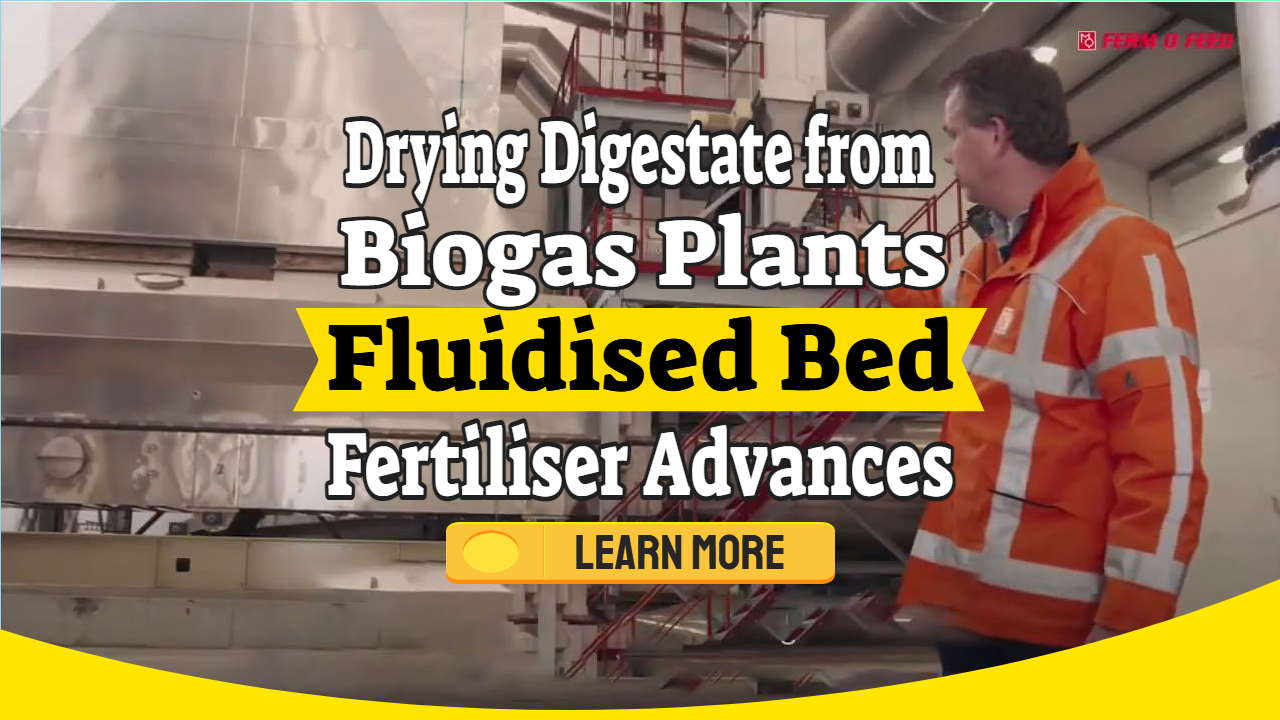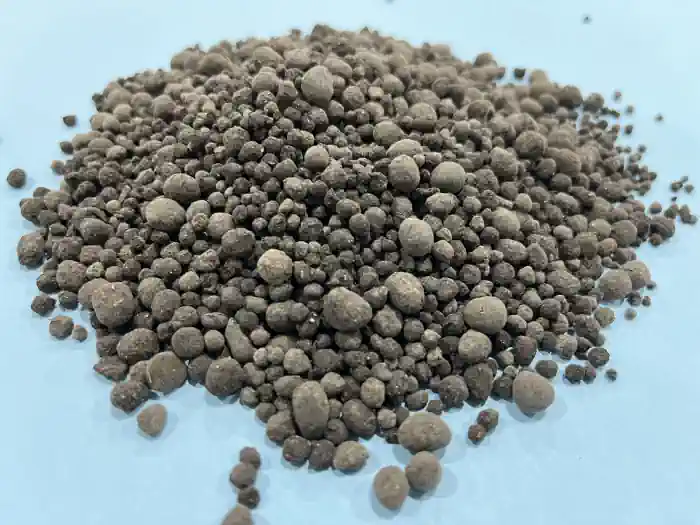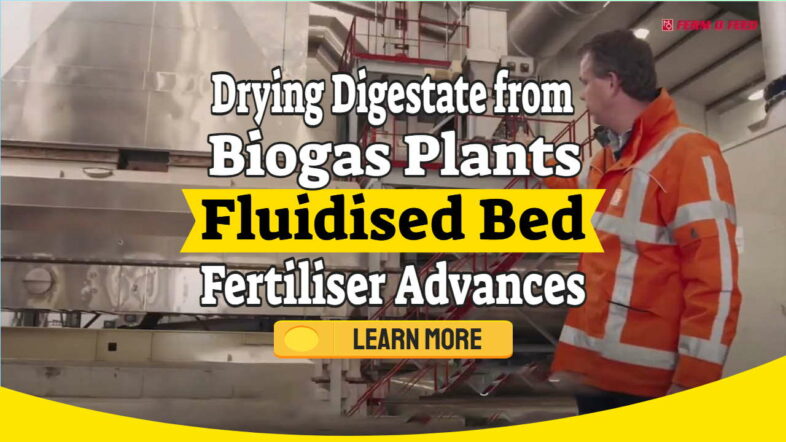Drying digestate from biogas plants has major benefits. In the advanced TEMA Process™ a fluidised bed dryer dries the residual waste after digestion (the solid and fibrous (thick) portion of the digestate slurry).
The mixed stream of the thick fraction and the concentrated thin fraction is dewatered to 70-75% Moisture Content. This is followed by fluidised bed thermal drying, using waste heat from the biogas CHP heat exchangers or other alternative heat sources.
The liquid portion which is drained away first during screening in a filter-press or a digestate separator is already a valuable fertiliser. The resulting digestate liquid is close to 95% water. It is dewatered in a vacuum evaporator and mixed back with the thick fraction from the filter press.
Digestate Drying for Nutrient Recovery
Drying this mixture in the Fluidized bed dryer from TEMA gives a unique granulate fertilizer, which is high in nutrient and organic value.
The digestate liquid may be used on-farm where it is produced and sold locally to other farms (subject to local regulations regarding such as the Animal By-products Regs., the presence of heavy metals, and crop nutrition requirements).
Although thermal drying usually makes use of surplus heat from a combined heat and power (CHP) engine, in some cases, the heat is provided by a dedicated biogas boiler.

Advances in Digestate Drying Mean that Making Natural Renewable Fertiliser is Now Very Viable
More efficient processes have been developed to extract the maximum benefit from Municipal Solid Waste (MSW) and Agricultural resources generally, and especially organic waste, as the world becomes more focused on recycling waste materials wherever possible.
The Dutch company TEMA Process offers fluid bed dryers for the following applications:
- making a granular fertiliser from digestate
- increasing the calorific value and stability of RDF (Refuse Derived Fuel), biomass, and sludge.
They do this as experts with extensive experience in the design and supply of tailored solutions for the drying of bulk materials.
TEMA Process fluid bed dryers can operate at relatively low drying air temperatures. Using waste heat from co-gen sets, boilers, or other sources is their preferred energy source for dryer heating.
The Benefits of Drying Digestate
Drying creates an odourless dry fertilizer that can be applied to crops. The dried material is a compact granulate. This significantly reduces storage and transportation costs.
Secondly, once dried the digestate can be stored to be used when it is needed for crop growth at any time of the year.
Drying digestate from biogas plants can be accomplished using a variety of energy sources in addition to the waste gas engine jacket heat or waste heat from a combined heat and power unit (CHP).
In many cases, solar energy, or exhaust air from a microturbine is used to dry the digestate. On rare occasions, waste biogas plant heat may also be converted into electricity and directed to the process of digestate drying. However, as this is usually done more to maximise the sale of electricity as green energy for revenue and tax break reasons it is not a recommended technical option.
During drying, digestates emit ammonia gas. This is an air pollutant but can be put through a water stripper to remove it from the dryer off-gas to make a further nitrogen fertiliser product.
Digestate Dryers in Use Today
Currently, approximately 500-700 digestate dryers are in use in Germany. This technology meets strict EU regulations while producing transportable and storable fertilizer.
In addition, the process reduces emissions when compared to land spreading of the mixed wet digestate. Drying plus pasteurisation also meets the strict hygienic standards required by the EU.
The result is a biogas fertilizer that emits significantly less ammonia than spreading other digestate-based fertilisers.

Better Separation and Digestate Drying Solves Past Problems
A growing number of biogas plants have been built across the world and are an important source of revenue for many farmers. However, this technology has until now had serious drawbacks.
Firstly, digestates have a high amount of ammonia, and they were until recently difficult to separate into liquid and solid fractions. That problem was solved by the development of cheap and reliable screw separators.
The second problem was storage space for the wet materials and the lack of availability of all-year-round farmland spreading space, due to run-off causing water pollution.
Too much untreated raw digestate spreading in any one area is counterproductive, and great care must be taken to avoid run-off resulting in the nearby rivers and/or groundwater pollution.
Drying digestate from biogas plants is a good way to combat these problems and makes the AD process yet more efficient and environmentally friendly.
How Drying Digestate Creates Added-Value
Another benefit of drying digestate from biogas plants is that it creates added value as a product.
The dried digestate fertiliser product has a far wider market and is a highly valuable fertilizer. This material can be stored for long periods and has a high dry matter content of 85% to 90%.
The dried digestate is also easy to transport and can be spread over larger areas than when in liquid form.
Furthermore, it is better accepted by local communities because it does not cause a significant risk of contaminating the environment or causing river and groundwater pollution which is damaging agricultural areas globally.
Many biogas plants, in operation now, can generate up to 50 tons of digestate per day. The digestate from these plants is mainly used as liquid fertilizer and, until now, only a minor part was dried in a waste-heat or solar dryer.
Anaerobic Digestion Facility Digestate Drying Predicted to Grow
But there are signs that this will rise rapidly. The change will be rapid now that low-energy consumption CHP heated digestate drying technology is available.
The driving forces behind this development are:
- the high cost of energy which has meant that fossil fuel/ mineral fertilisers have risen dramatically in price
- the war in Ukraine which has led to shortages in the supply of the natural gas needed for mineral fertiliser production, and
- shortages of mineral mined/chemical fertilisers due to factories closing.
Why Stop at Filter Press or Belt Dewatering?
Filter press or belt dewatering have in the past been the established methods for reducing water content but the latest high-performance fluidized bed dryers are better as follows:
- can be used to produce a solid in granular form which is ideal for immediate bagging and sale
- continuous automatic process operation
- low maintenance
- lower water content and much more controllable drying
- economical when waste heat is used.
Additionally, a fluidized bed drying system can be cost-effective, enabling operators to save hundreds of Euros a day and in jurisdictions of subsidy for renewable heat production receive a CHP RHI bonus.
Many biogas plant operators go no further than spreading their screw-press-separated liquid digestate and solid fibres. But why stop there?
Systems are available that are suitable for drying up to 100 tons of digestate per day and by using fluidised bed technology drying they can provide enormously added value:
- reduce sludge storage space drastically
- produce granules equally as handleable as pellets, and
- pay for themselves with a short ROI period.
The dried mineral-based fertiliser replacement product is far more in demand now than ever before, and will only rise in popularity as time goes on.
Conclusion
A high-quality digestate dryer can turn organic digestate waste which would cost in excess of $100/tonne to dispose of in a landfill, or by incineration, into a product. Not only that, a product which is valuable and easy to sell/in high demand and a much sought-after fertiliser commodity.
Since the rise in energy prices took place, drying digestate from biogas plants has become very profitable when high-performance fluidized bed drying methods are followed.
More information on high-performance fluidized bed drying is available from TEMA PROCESS






What exactly is the analysis of the digestate?